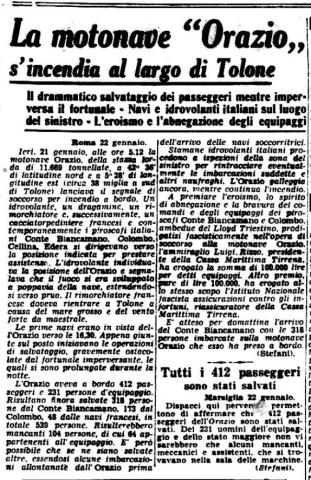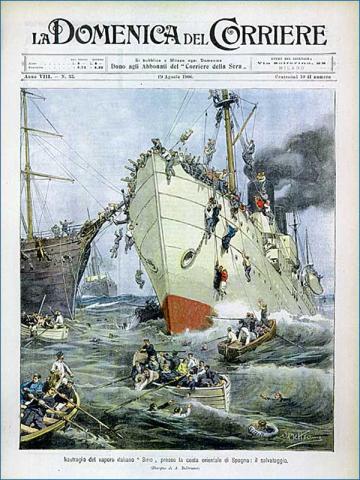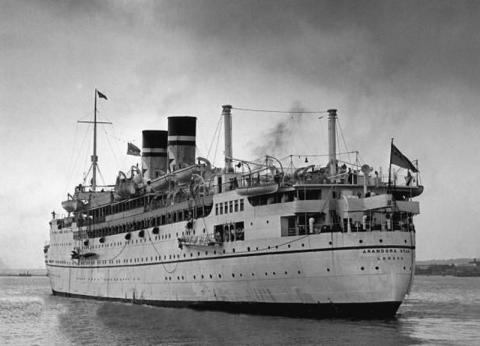Tragedies at sea
Ship was the only means of long-distance travel between the 19th and 20th centuries. Sea journeys were often long and difficult: engine failures, bad weather, disease and poor sanitary conditions made the crossings extremely hazardous. Many people set sail never to return.
On the night of 24 November 1880, the Oncle Joseph, with 350 emigrants on board, hit the Ortigia and sank in just eight minutes; 320 people died. A few years later, in 1888, the steamer Sud America was on its way back to Genoa when it collided with the cargo ship France; 80 people died.
The Carlo R set sail from Naples in the summer of 1894, carrying some 1400 emigrants, bound for Rio de Janeiro. Cholera spread among the passengers, the ship did not dock and the captain changed route for Genoa. The situation deteriorated and measles also began to spread. There were more than 200 deaths.
In 1898, the Bourgogne ran into a thick bank of fog. The captain did not slow down and the ship struck a steel sailing ship, the Cromartyshire. A similar fate befell 365 people on board the Sirio, which ran into the “Bajo de Fuera” undersea mountain in the Hormigas Islands on 4 August 1906 due to an error by the captain. The disaster of the Titanic was also caused by an error on the part of the helmsman: there were not many Italians on board, but Emilio Portaluppi and Argene Genovesi were among the survivors.
During the war years, some ships got caught in the crossfire: the steamer Ancona sank under the gunfire of a U-38 in 1915, with the death of 206 people. The Arandora Star, on the other hand, was an overcrowded prison ship and, in the summer of 1940, it collided with a German submarine: it was fractured and the rescue attempts were delayed. 808 people died, including 446 Italians.
Poor maintenance also claimed victims. The Principessa Mafalda's last voyage on 25 October 1927 was littered with minor accidents and breakdowns. When the propeller slipped out, dragging the support axle with it, the ship took on a lot of water. The ship was old and the lifeboats failed to work properly; the number of victims was between 314 and 324. A storm with strong winds and high waves took the motor vessel Orazio by surprise, causing a series of explosions on board; the rescue services only arrived the next day. There were about 114 victims.
-
TragediesDal 1861 al 1900
Timeline
-
1880
On the night of 24 November 1880, the Oncle Joseph hit the Ortigia and sank in just eight minutes.
-
1888
In 1888, the steamer Sud America was on its way back to Genoa when it collided with the cargo ship France.
-
1894
The Carlo R set sail from Naples in the summer, cholera spread among the passengers. The situation deteriorated and measles also began to spread.
-
1898
The Bourgogne ran into a thick bank of fog. The captain did not slow down and the ship struck a steel sailing ship.
-
1906
The Sirio ran into the “Bajo de Fuera” undersea mountain in the Hormigas Islands on 4 August.
-
1912
The disaster of the Titanic was caused by an error on the part of the helmsman.
-
1915
The steamer Ancona sank under the gunfire of a U-38.
-
1940
The Arandora Star was an overcrowded prison ship. In the summer it collided with a German submarine.
-
1927
The Principessa Mafalda's last voyage on 25 October was littered with minor accidents and breakdowns. When the propeller slipped out, dragging the support axle with it, the ship took on a lot of water.
-
1940
A storm with strong winds and high waves took the motor vessel Orazio by surprise, causing a series of explosions on board.



